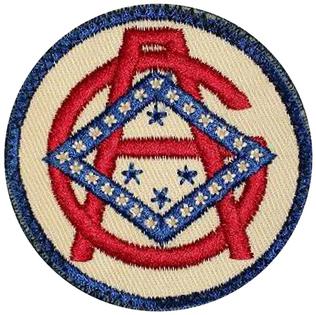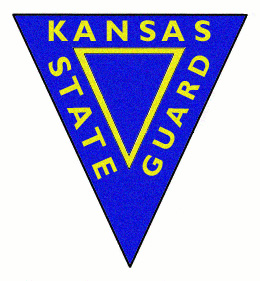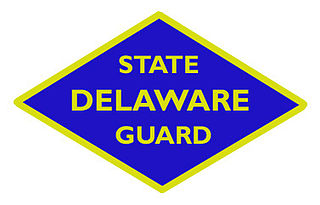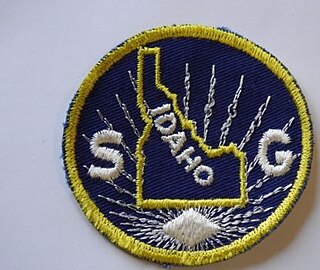
State defense forces (SDF); also known as state military, state military force(s), state guards, state militias, or state military reserves) in the United States are military units that operate under the sole authority of a state government. State defense forces are authorized by state and federal law and are under the command of the governor of each state.

Fort McClary is a former defensive fortification of the United States military located along the southern coast at Kittery Point, Maine at the mouth of the Piscataqua River. It was used throughout the 19th century to protect approaches to the harbor of Portsmouth, New Hampshire and the Portsmouth Naval Shipyard in Kittery. The property and its surviving structures are now owned and operated by the State of Maine as Fort McClary State Historic Site, including a blockhouse dating from 1844.

A naval militia in the United States is a reserve military organization administered under the authority of a state government. It is often composed of Navy, Marine Corps, and Coast Guard reservists, retirees and volunteers. They are distinguishable from the U.S. Coast Guard Auxiliary which is a federally chartered civilian volunteer component of the U.S. Coast Guard and falls under the command of the Commandant of the Coast Guard through the Chief Director of the Auxiliary, and the United States Maritime Service and United States Merchant Marine, both of which are federal maritime services.

The Virginia Defense Force (VDF) is the official state defense force of Virginia, one of the three components of Virginia's state military along with the Virginia National Guard which includes the Virginia Army National Guard, the Virginia Air National Guard, and the unorganized militia. As of 2019, the VDF has approximately 250 soldiers. The VDF is the descendant of the Virginia State Guard, the Virginia Regiment, and ultimately the Colonial Virginia militia of the Virginia Colony.
The Maine Department of Defense, Veterans, and Emergency Management (DVEM) is a government agency of Maine. It comprises the two components of the Maine National Guard, the Maine Army National Guard and the Maine Air National Guard, the Bureau of Veterans' Affairs, the Maine Emergency Management Agency, and when it is active, the Maine State Guard. The Adjutant General of Maine, Brigadier General Doug A. Farnham, commands the Maine National Guard and serves as the State's Commissioner of Defense, Veterans, and Emergency Management (DVEM). The Maine Army and Air National Guard has responded to every call of the State and Nation since before the Revolutionary War. Their soldiers and airmen are trained to high standards and are ready to respond to combat missions, domestic emergencies, counterdrug efforts, reconstruction missions and more.

The Wisconsin State Defense Force (WSDF) is the currently inactive state defense force of the State of Wisconsin authorized by Wisconsin law. As a state defense force, the Wisconsin State Defense Force, alongside the Wisconsin National Guard, is organized under the Wisconsin Department of Military Affairs as a part of the military forces of Wisconsin. However, unlike the National Guard, the State Defense Force is a purely state-controlled organization and cannot be deployed outside the state of Wisconsin. When any part of the Wisconsin National Guard is called into service of the United States, the adjutant general may recruit volunteers to the WSDF to serve within the borders of Wisconsin.

The Arkansas State Guard was the official state defense force of the state of Arkansas during World War II. The Arkansas State Guard was created to fulfill the state missions of the Arkansas National Guard while the National Guard was deployed abroad during World War II. As a military unit trained and funded solely by the state, it was immune to federal activation and deployment, unlike the National Guard. As a part of the official militia of the state of Arkansas, it traces its roots back to the militias which fell under state authority prior to the Militia Act of 1903. The Arkansas State Guard is currently inactive following deactivation after the end of World War II; however, the legal framework for a state defense force still exists, making future reactivation of the Arkansas State Guard by the Arkansas General Assembly legally permissible.
The state of Maine organized seven companies of militia infantry for coast guard duties in the Union Army during the American Civil War. They primarily served to garrison coastal fortifications in Maine, with two companies sent to the Defenses of Washington, DC. Very little is known about the organization or command structure of these companies, beyond their commanding officers at the usual rank of captain. Over 800 men served in the seven companies. A New York Times article in 1864 stated that Vice President Hannibal Hamlin served at Fort McClary as a private in the Maine State Guard; some subsequent citations erroneously confuse this with the Maine Coast Guard.

The Kansas State Guard was the official state defense force of the state of Kansas during each of the world wars. The unit was first created during World War I, and was later reactivated during World War II. When the Kansas National Guard was federalized and deployed during each of the world wars, the state of Kansas was forced to raise and maintain its own military force in order to protect against saboteurs, quell riots, and perform other duties which would normally fall to the National Guard. Unlike the National Guard, which could be federalized and deployed abroad, the State Guard was funded and equipped solely by the state and as such was immune to deployment. The Kansas State Guard is authorized under Kansas law. In 2007, the Kansas Legislature considered a bill which would create a modern Kansas State Defense Force. The bill did not pass.

The Florida State Guard (FSG) is the currently inactive state defense force of the state of Florida, which was active during World War II. The FSG was created to serve as a stateside replacement for the Florida National Guard while the National Guard was deployed abroad. Unlike the Florida National Guard, the Florida State Guard was trained and funded by the state and therefore could not be federalized and was available to the governor of Florida whenever needed. Although the force was disbanded, Florida law allows the governor of Florida to create and maintain a Florida state defense force should he or she decide to do so.

The Missouri State Defense Force (MSDF), formerly known as the Missouri Reserve Military Force, is the official state defense force of Missouri. As a state defense force, the MSDF is a reserve military force which serves parallel to the Missouri National Guard. As the MSDF falls solely under the command of the state of Missouri, it cannot be federalized or deployed outside the borders of Missouri, unlike the National Guard. Although the MSDF and the Missouri National Guard are separate organizations, the MSDF's primary scope is to work alongside the National Guard during stateside operations, or in lieu of the National Guard when the National Guard is deployed outside of Missouri. Along with the Missouri Army National Guard, the Missouri Air National Guard, and the Missouri Naval Militia, the Missouri State Defense Force is recognized under Missouri law as part of the organized militia of Missouri.

The Delaware State Guard is the currently inactive state defense force of the state of Delaware, which was active during both World War I and World War II. As the official militia of the state, the Delaware State Guard was created with the intent of acting as a stateside replacement for the Delaware National Guard while the National Guard units were deployed abroad.
The Hawaii Territorial Guard was the state defense force of Hawaii during World War II. As a result of the National Guard of Hawaii being federalized for the duration of the war, the Hawaii Territorial Guard was created to serve as the stateside replacement for the National Guard. During the war, it was the sole military force available to the Governor of Hawaii as its captain general to use in defense of the state. Unlike the National Guard, as a state defense force, the Hawaii Territorial Guard was not subject to federalization or deployment outside of the borders of Hawaii, but rather answered only to the governor.
The Nebraska State Guard (NSG) is the currently inactive state defense force of the state of Nebraska, which was activated during both World War II and the Vietnam War. As a state defense force, the NSG served on as a component of the organized militia of Nebraska, serving as reservists who trained periodically but could be called up during an emergency; however, unlike the Nebraska National Guard, the Nebraska State Guard could not be federalized or deployed outside the state. Rather, when the National Guard was deployed, the purpose of the State Guard was to assume the stateside duties of the National Guard.

The Louisiana State Guard (LSG) is the official state defense force of the state of Louisiana. The LSG was first created during World War II. As a state defense force, the LSG is a part of the state militia of Louisiana, and can serve as a stateside replacement of the Louisiana National Guard while the National Guard is deployed. Unlike the Louisiana National Guard, the Louisiana State Guard is solely under state control, and cannot be federalized or deployed outside of Louisiana, guaranteeing additional soldiers will always be available to the governor to deploy in response to crises.

The New Hampshire State Guard (NHSG) is the currently unorganized state defense force of New Hampshire. The purpose of the State Guard is to augment or replace the New Hampshire National Guard by assuming the National Guard’s stateside duties when any part of the National Guard is federalized. However, unlike the National Guard, the State Guard is a purely state-level military force which cannot be federalized or deployed outside the state of New Hampshire. The NHSG is a component of the organized militia of New Hampshire.
The South Dakota State Guard is the currently inactive state defense force of South Dakota. The State Guard is recognized as a military force separate from the South Dakota National Guard. Unlike the National Guard, the State Guard is a purely state-level military force under the command of the Governor of South Dakota, and cannot be federalized or deployed outside the borders of the state. The South Dakota State Guard was active during World War I, World War II, and the Vietnam War and provided military protection to the state of South Dakota while the National Guard was in federal service.

The Rhode Island State Guard is the currently inactive state defense force of Rhode Island. As a state defense force, the Rhode Island State Guard served as a state military unit which assumed the stateside duties of the Rhode Island National Guard when the National Guard was in federal service. However, unlike the National Guard, the State Guard, when organized, answers solely to the Governor of Rhode Island and by law cannot be federalized or deployed outside the borders of Rhode Island.
The New Jersey State Guard, previously known as the New Jersey State Militia, is the inactive state defense force of New Jersey, and is one of New Jersey's authorized military forces. The State Guard served as the stateside replacement for the New Jersey National Guard during World War I and World War II when the National Guard was deployed abroad.

The Idaho State Guard, formerly known as the Idaho Home Guard, is the inactive state defense force of Idaho. The Idaho State Guard was created to replace the Idaho National Guard as a stateside homeland security force while the National Guard was in federal service. A recent attempt at reactivation is being led by the Idaho State Guard Association 2016














